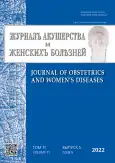New possibilities of differential diagnosis of uterine fibroids and adenomyosis nodes based on a complex ultrasound assessment
- Authors: Shalina M.A.1, Nagorneva S.V.1,2, Yarmolinskaya M.I.1,3
-
Affiliations:
- The Research Institute of Obstetrics, Gynecology and Reproductology named after D.O. Ott
- Sestroretskaya Multiprofile Clinic Ltd.
- North-Western State Medical University named after I.I. Mechnikov
- Issue: Vol 71, No 5 (2022)
- Pages: 75-84
- Section: Original study articles
- URL: https://journals.rcsi.science/jowd/article/view/125974
- DOI: https://doi.org/10.17816/JOWD110878
- ID: 125974
Cite item
Abstract
BACKGROUND: Ultrasound is widely used in routine practice to diagnose various forms of adenomyosis and uterine fibroids. However, due to the lack of unified criteria, hypo- or overdiagnosis of internal endometriosis is possible. Moreover, there are a number of difficulties in the differential diagnosis of nodular adenomyosis and uterine fibroids.
AIM: The aim of this study was to develop a complex technique for the differential diagnosis of uterine fibroids and adenomyosis nodes.
MATERIALS AND METHODS: We applied a complex ultrasound technique with a detailed and consistent application of the following tools — 3D reconstruction, elastography, color Doppler, 3D power Doppler (glass body mode). The study was conducted in 124 patients of reproductive age with subsequent intraoperative and histological confirmation of the diagnosis.
RESULTS: After the proposed ultrasound technique, uterine fibroids were diagnosed in 112 (90.3%) patients, of whom 85 (75.9%) patients had uterine fibroids combined with a diffuse form of internal endometriosis. Nodular adenomyosis was diagnosed in 12 (9.7%) patients. The additional examination and surgical treatment showed that the preliminary diagnosis of uterine fibroids was confirmed in 110 out of 112 women, and in two other cases, nodular adenomyosis was diagnosed. Eleven (91.7%) out of 12 patients were diagnosed correctly with nodular adenomyosis by the complex ultrasound examination, while in one case the preliminary diagnosis proved to be incorrect, with a conglomerate of three myomatous nodes detected as a result of surgical treatment. Thus, based on the technique we developed, the correct diagnosis was made in 121 (97.6%) patients. Misdiagnosis in three cases was associated with a history of a long-term medical treatment of adenomyosis and therefore Doppler and elastography results had lower sensitivity.
CONCLUSIONS: The development of the described complex ultrasound technique allows for accurately diagnosing the form of adenomyosis, identifying early forms of the disease and differentiating adenomyosis nodes from myomatous nodes, which is necessary for the correct diagnosis, the right choice of the management tactics and the necessary treatment.
Full Text
##article.viewOnOriginalSite##About the authors
Maria A. Shalina
The Research Institute of Obstetrics, Gynecology and Reproductology named after D.O. Ott
Email: amarus@inbox.ru
ORCID iD: 0000-0002-5921-3217
Scopus Author ID: 57200072308
ResearcherId: A-7180-2019
MD, Cand. Sci. (Med.)
Russian Federation, Saint PetersburgStanislava V. Nagorneva
The Research Institute of Obstetrics, Gynecology and Reproductology named after D.O. Ott; Sestroretskaya Multiprofile Clinic Ltd.
Email: stanislava_n@bk.ru
ORCID iD: 0000-0003-0402-5304
SPIN-code: 5109-7613
ResearcherId: К-3723-2018
MD, Cand. Sci. (Med.)
Russian Federation, Saint Petersburg; Saint PetersburgMaria I. Yarmolinskaya
The Research Institute of Obstetrics, Gynecology and Reproductology named after D.O. Ott; North-Western State Medical University named after I.I. Mechnikov
Author for correspondence.
Email: m.yarmolinskaya@gmail.com
ORCID iD: 0000-0002-6551-4147
SPIN-code: 3686-3605
Scopus Author ID: 7801562649
MD, Dr. Sci. (Med.), Professor, Professor of the Russian Academy of Sciences
Russian Federation, Saint Petersburg; Saint PetersburgReferences
- Yarmolinskaya MI, Aylamazyan EK. Genital’nyy endometrioz. Razlichnye grani problemy. Saint Petersburg: Eco-Vector; 2017. (In Russ.)
- Adamyan LV, Kulakov VI. Endometriozy: Rukovodstvo dlya vrachey. Moscow, 1998. (In Russ.)
- Gordts S, Grimbizis G, Campo R. Symptoms and classification of uterine adenomyosis, including the place of hysteroscopy in diagnosis. Fertil Steril. 2018;109(3):380–388. doi: 10.1016/j.fertnstert.2018.01.006
- Minzdrav RF. Klinicheskie rekomendatsii. Mioma matki. 2020. (In Russ.). [cited 20.09.2022]. Available from: http://disuria.ru/_ld/10/1034_kr20D25D26MZ.pdf
- Yarmolinskaya MI, Shalina MA, Khachaturyan AR, et al. Adenomyosis: from scientific discoveries to the practical aspects of prescribing drug therapy. Akusherstvo i Ginekologiya. 2020;(3):182–190. (In Russ.). doi: 10.18565/aig.2020.3.182-190
- Cunningham RK, Horrow MM, Smith RJ, et al. Adenomyosis: a sonographic diagnosis. Radiographics. 2018;38(5):1576–1589. doi: 10.1148/rg.2018180080
- Fascilla FD, Cramarossa P, Cannone R, et al. Ultrasound diagnosis of uterine myomas. Minerva Ginecol. 2016;68(3):297–312.
- Munro MG, Critchley HO, Broder MS, et al; FIGO Working Group on Menstrual Disorders. FIGO classification system (PALM-COEIN) for causes of abnormal uterine bleeding in nongravid women of reproductive age. Int J Gynaecol Obstet. 2011;113(1):3–13. doi: 10.1016/j.ijgo.2010.11.011
- Van den Bosch T, Dueholm M, Leone FP, et al. Terms, definitions and measurements to describe sonographic features of myometrium and uterine masses: a consensus opinion from the Morphological Uterus Sonographic Assessment (MUSA) group. Ultrasound Obstet Gynecol. 2015;46(3):284–298. doi: 10.1002/uog.14806
- Woźniak A, Woźniak S. Ultrasonography of uterine leiomyomas. Prz Menopauzalny. 2017;16(4):113–117. doi: 10.5114/pm.2017.72754
- Benacerraf BR, Shipp TD, Bromley B. Which patients benefit from a 3D reconstructed coronal view of the uterus added to standard routine 2D pelvic sonography? AJR Am J Roentgenol. 2008;190(3):626–629. doi: 10.2214/AJR.07.2632
- Frank ML, Schäfer SD, Möllers M, et al. Importance of transvaginal elastography in the diagnosis of uterine fibroids and adenomyosis. Ultraschall Med. 2016;37(4):373–378. doi: 10.1055/s-0035-1553266
- Stoelinga B, Hehenkamp WJ, Brölmann HA, et al. Real-time elastography for assessment of uterine disorders. Ultrasound Obstet Gynecol. 2014;43(2):218–226. doi: 10.1002/uog.12519
- Gazhonova VE, Churkina SO, Khokhlova EA. et al. Clinical application of sonoelastography a new technique in gynecology. Kremlevskaya meditsina. Klinicheskiy vestnik. 2008;(2):18–23. (In Russ.)
- Patent RF na izobretenie № 2764106 / 13.01.2022. Byul. № 2. Nagorneva SV, Shalina MA, Yarmolinskaya MI, et al. Sposob diagnostiki adenomioza.
- Nagorneva SV, Shalina MA, Yarmolinskaya MI et al. Comprehensive method of ultrasound diagnosis of adenomyosis. Journal of Obstetrics and Women’s Diseases. 2021;70(6):73–82. (In Russ.). doi: 10.17816/JOWD83066
Supplementary files














